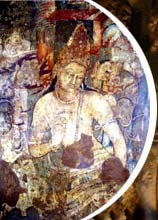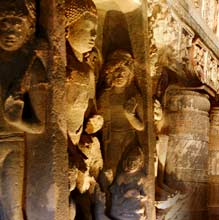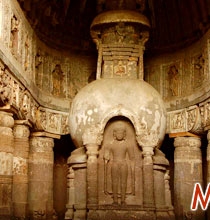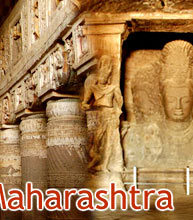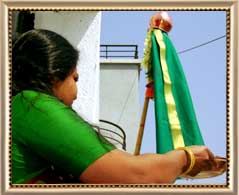 Gudi
Padwa is one of the major festivals celebrated by the people of
Maharashtra. It falls on the first day of the Hindu month of Chaitra
(somewhere around March-end or April-start) and is celebrated in the
state as the New Year's Day. The day on which the festival takes place
coincides with the first day of Hindu National Calendar (as adopted by
the Government of India). Gudhi Padwa is also celebrated in some states
of South India, though the name (Ugadi) by which it is known there is
different.
Gudi
Padwa is one of the major festivals celebrated by the people of
Maharashtra. It falls on the first day of the Hindu month of Chaitra
(somewhere around March-end or April-start) and is celebrated in the
state as the New Year's Day. The day on which the festival takes place
coincides with the first day of Hindu National Calendar (as adopted by
the Government of India). Gudhi Padwa is also celebrated in some states
of South India, though the name (Ugadi) by which it is known there is
different.The Brahma Purana
Even Sindhis celebrate a festival on the same day as Gudhi Padwa and it is known as Cheti Chand. The festival is believed to mark the commencement of the spring season in India, known as Vasant/Basant. In the Brahma Purana, it has been written that it was on this day only that Lord Brahma recreated the world, after the inundation that devastated it. Each and every moment of the day on which Gudi Padwa is celebrated is considered to be very auspicious. This is the reason why the festival is celebrated with such grand festivities.
Celebrations
The day of Gudi Padwa starts with the cleaning ritual, in which the house is fully cleaned (in case of villages, it is then covered with fresh cow-dung). Thereafter, women and children indulge in the drawing as well as coloring of intricate rangoli designs on the doorsteps. Usually, vibrant colors are chosen for the rangoli, in keeping with the spirit of the festival. Every member of the family wears new clothes and eats soonth panak and chana usal, the specialties of the day.
Other delicacies made on Gudhi Padwa festival include Shrikand and Poori. In the earlier days, family members used to start the day by eating the leaves of neem tree. However, the tradition is not as rigidly followed these days. Usually, people consume a paste of neem leaves (combined with ajwain, jaggery and tamarind). The leaves as well as the paste are believed to cleanse blood and toughen the immune system.
Gudi
Gudi, meaning Brahma's flag (Brahmadhvaj), is hoisted by people on the day of Gudi Padwa, as a symbol of victory of good over evil. It is also believed to ward off evil influences and bring prosperity and good luck into the house. Gudi is made by tying a bright green or yellow cloth, adorned with brocade (zari), to a long bamboo. Over the cloth, gathi (a type of sweet), neem leaves, a twig of mango leaves and a garland of red flowers is tied.
Thereafter, a silver or copper pot is placed over it in inverted position. Then, the Gudi is hoisted on the window or on the gate. The floor before Gudi is adorned with rangoli, made of a special powder of soft, white stone. Lastly, it is worshipped, while offering obeisance to the flag of Lord Brahma. Whatever be the state in which the festival is celebrated and whatever be its name, its significance as well as the scale of festivities surrounding it remains the same.

